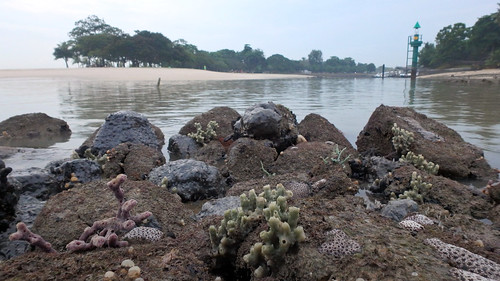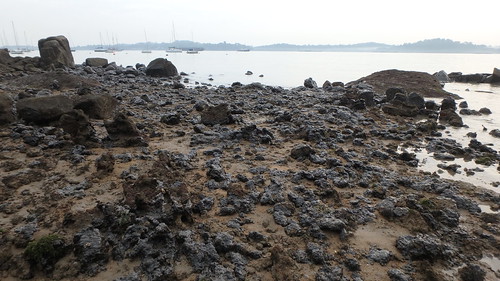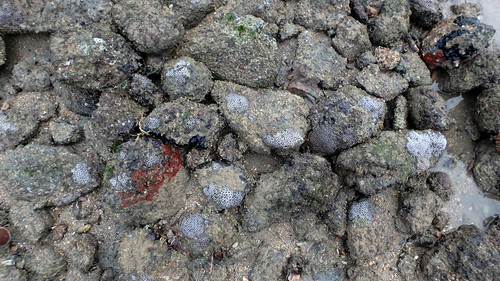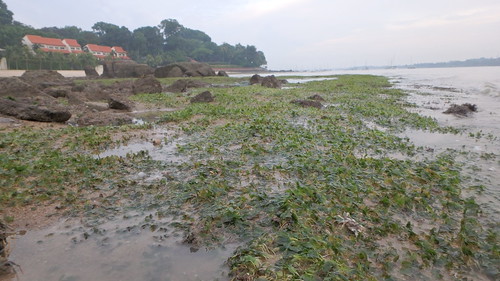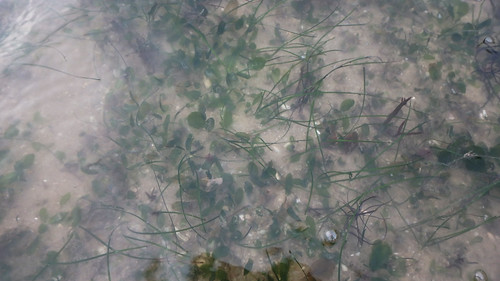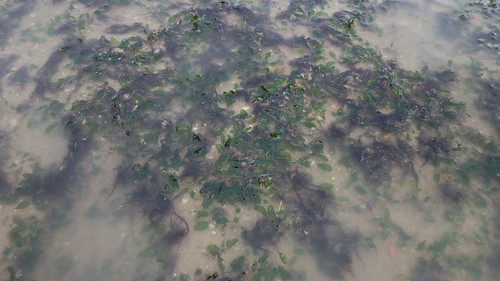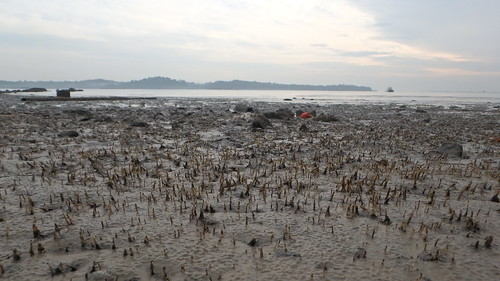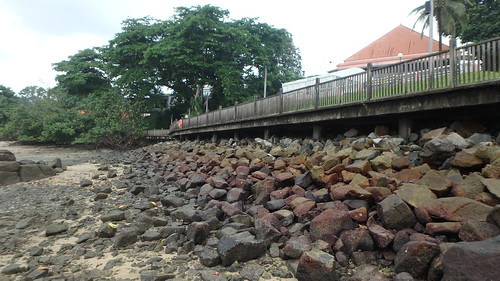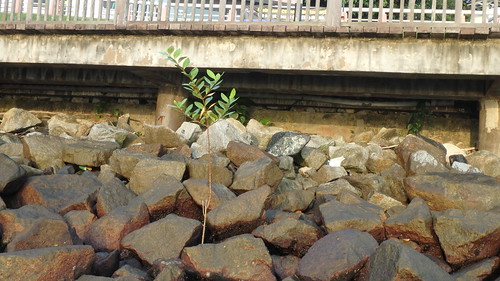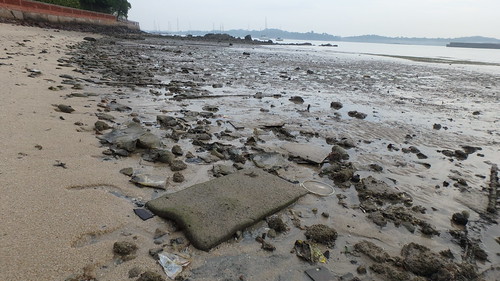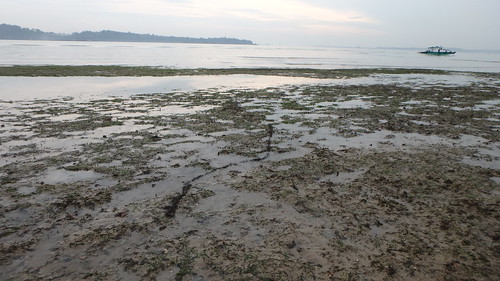I saw many sponges of a wider variety on the rocky shores there, as well as sea fans and other colourful marine life. The seagrasses appear fine and I saw some of the usual animals. I also checked out Changi Creek, the mangroves up the Creek. I did not see any signs of massive oil spill impact.
Here's a video clip of the colourful living rocky shores of Changi Creek.
There were many sponges of various kinds all over the rocks at the very low water mark.
The most abundant sponge on the rocky shore remains the Melted chocolate sponge.
I also saw many small to medium sized sea fans growing below the super low water mark. The sea fans were mostly Gnarled sea fans and Candelabra sea fans. Abel noticed that on one washed up Candelabra sea fan there was a cluster of squid eggs. The eggs looked like they had been chewed on. Oh dear.
There were many patches of Zebra coral. And many small Pink flowery soft corals, As well as a few tiny to small Ball flowery soft corals, one with a Ghost brittle star that we found find there.
I came across a small area with bleaching Zebra corals. But most of the Zebra corals I saw were alright.
Abel found a Blue feather star, and I saw a few tiny Blue-dotted flatworms. There were also several Fan worms.
The rocks were still lively at the high water mark. Some had patches of Little black nesting mussels. There were many Drills and clusters of them were laying eggs. I saw some Onch slugs. There were also many Thumbs-up sea squirts and Yellow clustered bead ascidians.
There were many Banded bead anemones in one corner of the bay, and Button zoanthids still dominated one corner of the bay. I saw one small Tiger anemone.
The meadows were all Spoon seagrass, mostly fresh and green. I did not see any bleaching seagrasses.
For the first time, I saw a small patch of Needle seagrass.
The seagrass meadows were alive too. I saw more than 20 tiny to small Haddon's carpet anemones. But I couldn't see any shrimps in them.
I saw a few Flowery sea pens, and several Cerianthids in the seagrass meadows with Phoronid worms.
As usual, there were lots of sea cucumbers. The seagrasses were dotted with small Warty pink sea cucumbers. I saw a few Orange sea cucumbers and a few tiny Thorny sea cucumbers. The sand bar was dotted with buried Ball sea cucumbers. I saw one Beige sea cucumber.
I saw a few small Biscuit sea stars and Abel pointed out a small orange Cake sea star.
There were small patches of filamentous hairy black stuff (Cyanobacteria?) on seagrasses and rocks.
There were also large patches of Gregarious tubeworms, forming a shaggy carpet on the low water mark. And some Solitary tubeworms too. The presence of delicate burrowing animals suggest the ground is alright.
On the seawall, no sign of the little mangrove sapling growing there that was somewhat oiled. Oh dear.
This what it looked like in June when I last saw it in Jun 2017.
Sadly, as usual, there remained a line of plastic litter along the mid-water mark. Many were coated in oil and this will remain a source of oil pollution until they are removed. Although this beach is cleaned everyday, only the high tide line is cleaned.
Alas, there are many abandoned fishing nets stuck on the sea wall and on the shores.
As well abandoned fishing lines on the seagrass meadows.
After the tide turned, I headed out to check Changi Creek itself. There are several large mangrove saplings growing near the seawall. The mudflats and seawall looks normal and I didn't see any signs of sheen. Although there is still the stain of oil on the drain wall. The boom across the drain has been removed. But the abandoned boom near the bridge is still there (!). There is some dead vegetation near the bridge.
I headed upstream to the mangroves at Changi Creek. The mangroves looked alright. No massive yellowing leaves or bare branches.Most of the Bakau kurap trees were producing propagules that were nice and long. I didn't see any propagules with odd colours.
I also saw some saplings under the big mangrove trees.
Abel spotted four Blue-spotted mudskippers and a Giant mudskippers. There were also many small fishes swimming in the Creek.
Some parts of the mud stream banks had Leaf oysters that seemed alive.
I didn't visit Changi Beach near Carpark 3 this time. It's a relief to see the shores did not seem too badly affected by the oil spill so far.
Posts about the Jan 2017 Johor Strait oil spill
- Survey on 14 Jun, six months after the oil spill
- Survey on 15 May, five months after the oil spill
- Survey on 27 Apr, four months after the oil spill
- Survey on 31 May, three months after the oil spill
- Survey on 13 Mar, two months after the oil spill
- Changi Creek
- Changi Creek mangroves
- Changi Beach at Carpark 2 and 3
- Changi seagrass meadows near Changi Point Ferry Terminal
- Round Ubin survey for oil spill impact and long-term monitoring
- Changi Creek and Sungei Ubin after the oil spill
- Oil spill at East Johor Strait: YOUR sightings part 2
- Changi Creek
- Changi Creek mangroves
- Changi Beach at Carpark 1 and 2
- Changi seagrass meadows near Changi Point Ferry Terminal
- How are Pasir Ris mangroves and seagrass meadows after the oil spill?
- Are we helping or harming when we 'clean' oiled mangroves?
- Oil spill at East Johor Strait: YOUR sightings
- Key happenings: Oil spill at East Johor Strait, Jan 2017
- Survey of oil spill spill impact on Ubin and mainland Singapore, 5 Jan 2017
- Oil spill near Pulau Ubin, 4 Jan 2017

